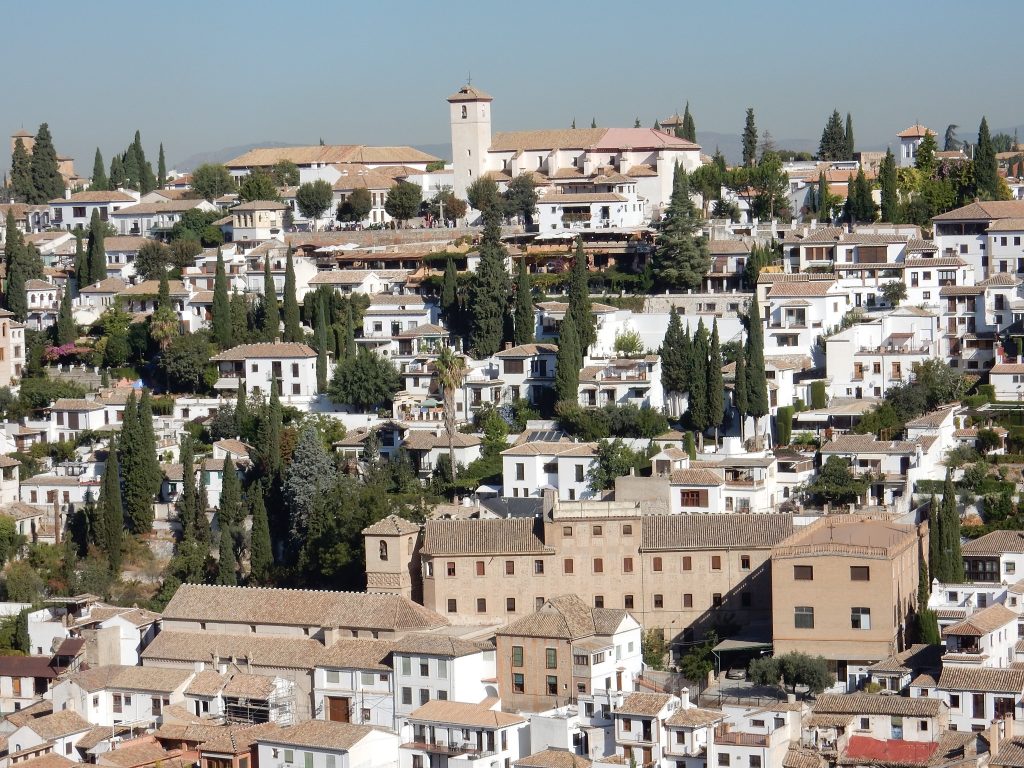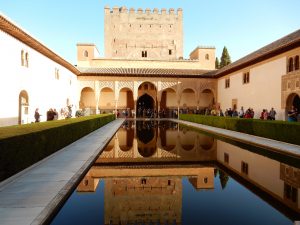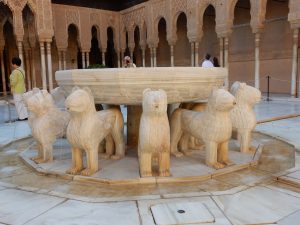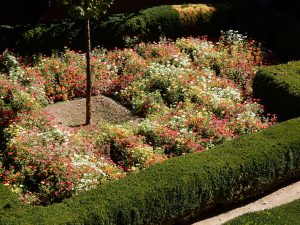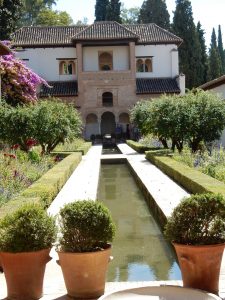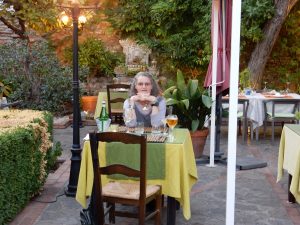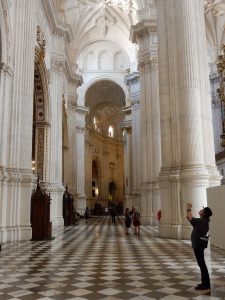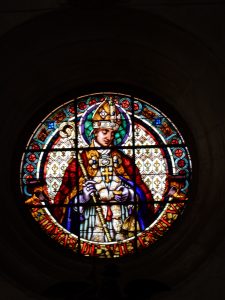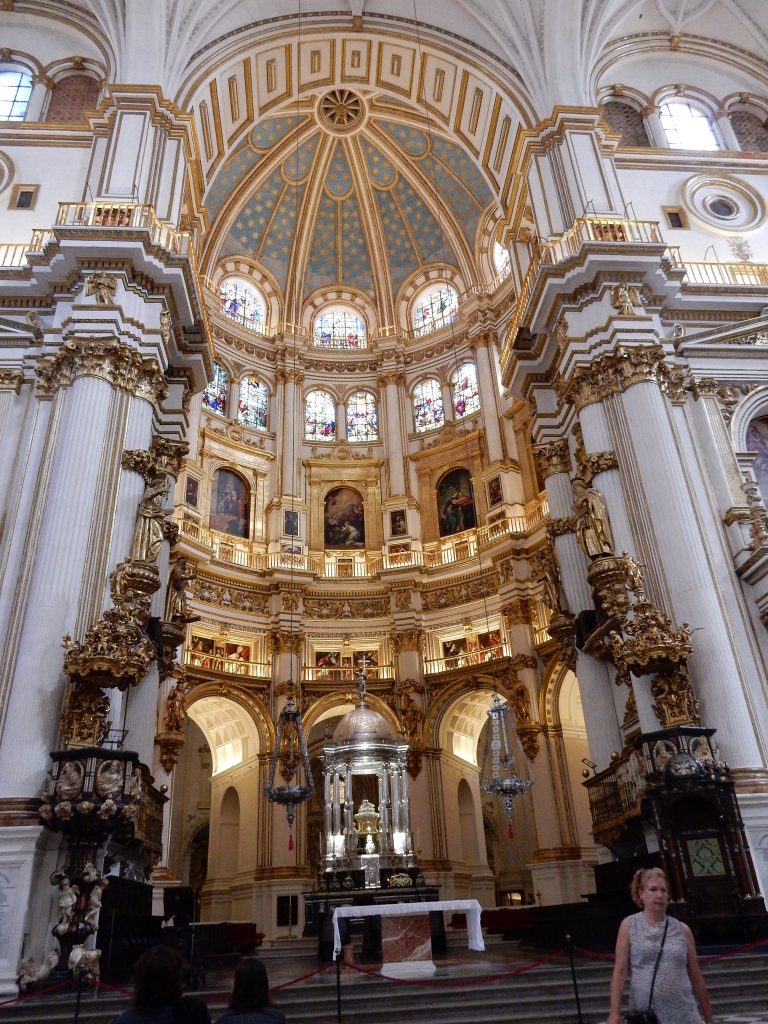September 24, 25
I suppose I should really give each full day in Granada its own post, but then I would be writing forever; we saw enough for at least two full-length posts.
On Thursday we got up early and went to the Alhambra. We got there by taxi from the Plaza Nuevo which is close to our apartment. the ride up was slower than we thought it would be and we spent a lot of time sitting in traffic. Our driver was concerned that we might think he was stalling so we engaged in a discussion about school days, traffic, and kids riding the buses to get to school. The streets in this part of Granada are very narrow and a stopped bus stops traffic in both directions. I know this would never occur in the States, but here some of the parents drive the kids to school, stop at the front door, let the kids out, and wait for them to get inside. More stopped traffic. The taxi driver practiced his English and I practiced my Spanish and he was very good about explaining things when I needed help.
Lines at the Alhambra ticket offices were very long, but we had purchased our tickets while we were still in New Mexico, so we got in pretty quickly. Timing is important at the Alhambra because one of the palaces lets people in according to a schedule and if you miss your slot, you don’t get in.
Last year the weather was overcast and we were in and out of rain while on the tour. This year the weather could not have been better and we were on our own and free to wander around.
We spent a lot of time at the Nasrid palace which has many rooms decorated with mosaic tiles and wooden ceilings that sometimes depict the skies. It seems that every part of the palace complements all of the other parts which is pretty remarkable when you consider how old the site is and how many “owners” it has had.
There is constant reconstruction going on and in the buildings surrounding the Lion’s Court, there are really interesting write-ups of how they are doing some of the restoration. Interestingly, they are using techniques that are several hundred years old because they work so well.
Every place one walks in the grounds of the Alhambra the paths are well kept and the trees and bushes and flower beds are kept to perfection which must be difficult given that 8,500 people pass through the grounds each day. The initial purpose of the Alhambra was to be a fortress and it has the walls and battlements to prove it. It is situated on a high overlook above the Albaicin district and it must have seemed impregnable.
In addition to the fortress/palace part of the grounds is the area called the Generalife palace and gardens. They were built in the early 1300s and served as a “getaway” for the caliph and other aristocrats. Islam depicts paradise as a place of water and gardens and the Generalife was envisioned as sort of a paradise on earth. I know that the current gardens were built in the early 20th century, but I don’t know how closely they resemble the original gardens. It doesn’t really matter because what is there now is is pretty astounding.
There are many kinds of flowers, bushes, and trees interspersed with reflecting pools and murmuring waters. The views from the Cerro del Sol (Sun Hill) that overlook old and new Granada are really great. We wandered around the gardens and in the parts of the palace that were open and took LOTS of pictures. [We have to figure out how to transfer Patricia’s pictures to my iPad so that you can see some of them.]
Sometimes when you re-visit a place it doesn’t seem as good as the first time. That is absolutely not the case with the Alhambra. This visit confirmed for us what a wonderful place it is.
I have mentioned that our apartment is in the Albaicin district. That is a very old part of the city and it is built on a number of hills. Walking around in the area can be a challenge because the streets are shared with cars (small) and motorcycles (fast) and tourists (oblivious) as well as with the local people. Small restaurants and smaller shops are interspersed with the houses. You can’t tell what a house is like from the outside because they all have white walls and tile roofs and most loom a couple of stories above the narrow streets. Inside there are often courtyards and trees and gardens. The house that holds our apartment is like that. Thursday night, after our busy day at the Alhambra we wanted to go out to eat but could not work up the enthusiasm for walking down the hill to the area where most of the restaurants are; actually, walking down is no problem, it is walking back up that involves real work.
Fortunately, we had been smelling restaurant smells in the area and we found, literally around the corner, the El Trillo restaurant. We had not noticed it in the day because its courtyard was closed up but when we went in we saw that it had a beautiful patio with about 20 tables and a view that overlooks the Alhambra. We had a very good meal and, best of all, were home in less than 2 minutes.
On Friday the weather was once again beautiful. We took a hop-on-hop-off tour of Granada on a little tram. We went up and down hills and al around the town so we now have a better feel for where thing are. I once again tried to take pictures from a moving bus and, once again, most of them did not turn out. Some parts of Granada are so hilly that all you can get is a glimpse of a house or a church or a winding street, much less get a picture.
Last year we did not have time to visit the Granada Cathedral (Cathedral of the Incarnation). This year it was on the must-see list. Friday afternoon we made our way there (everything is within walking distance in the old part of the city). The Cathedral was started in the early 1500s. It was built (no surprise) on the foundations of the city’s main mosque. This was, of course, shortly after the reconquest of Andalucia from the Moors.
It is stupendously large inside with soaring ceilings and large open spaces. As with other large Catholic churches, the walls are lined with elaborate chapels and there are many retablos (I would call them altar-pieces) around the circumference. The dome over the main altar draws one’s eye’s ever higher–which I suppose is its purpose. I don’t know if the stained glass is old or new, but it is bright and colorful. The doors are massive; probably 25 to 30 feet high and I can’t imagine how they could be moved.
There are two giant organs in the cathedral. I would have liked to hear them play. the church was not crowded at all so we were able to see nearly everything. We were both very impressed–leaving aside the question whether things like this should ever be built at all.
We had another good meal sitting outside the cathedral and looking at its massive walls.
Our short trip to Granada allowed us to re-visit some things we saw last year and to discover some new things. Whenever we were in our apartment, we had a view of the Alhambra that could not be matched.
